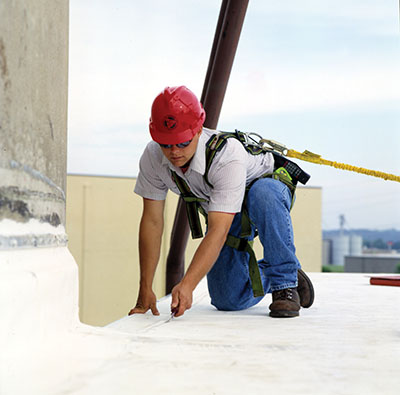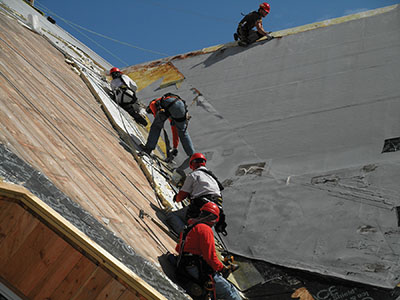How to evaluate and hire a safe roofing contractor for your next project.
If you want a roofing contractor that proactively addresses danger and risks, then your qualification process must also be proactive. Don’t anticipate that a contractor is being safe. When an accident happens, it’s too late to prevent it. Find out first how important safety is and what countermeasures are put in place to address risk. This information will help make a decision about who to contract with and provides peace of mind as the contractor you’ve hired executes the work.
Determine How Serious a Contractor is About Safety
Safety should be part of a roofing contractor’s culture and be practiced every day by every employee from the crew to top management. They should plan for potential falls and employ safety measures to prevent them. This not only protects the contractor’s employees, it also protects your property, employees, customers and your business.
How much does a roofing contractor emphasize training? What actions do they take when an employee violates safety procedures? Do they enforce a zero-tolerance safety policy by termination? Is a job hazard analysis completed and the results communicated before work begins? The answers to these questions can help you gauge management’s commitment to safety and enforcement of policies.
 Each employee that works on your roof should be trained on topics and tasks related to safe roofing practices; and since English is a second language for many in the roofing trade, your contractor should also provide the training in Spanish. Minimum training should include:
Each employee that works on your roof should be trained on topics and tasks related to safe roofing practices; and since English is a second language for many in the roofing trade, your contractor should also provide the training in Spanish. Minimum training should include:
• New-hire employee orientation.
• Globally Harmonized System of Classification and Labeling of Chemicals (GHS).
• Fire prevention and protection.
• Ladder safety.
• Company-specific safety and health policies.
• OSHA 10-hour.
• Fall protection.
• Deck replacement.
• Continuous on-the-job training.
• Job hazard analysis.
• Manual material handling and storage.
Aside from the ongoing safety programs initiated by a roofing contractor, there are several statistics that can help you evaluate the safety of prospective contractors. These numbers reveal the company’s safety performance history:
Total Incidence Rate (TIR)
TIR is an equation that calculates the number of recordable injuries and/or illnesses that a contractor experiences in a year per 100 full-time employees. This key safety metric is often used by companies to track the success of their own safety improvements and effectiveness of safety programs against the national average.
Lost Workday Incidence Rate (LWDIR or LWIR)
This statistic is similar to TIR, except that it uses the number of injuries and/or illnesses resulting in lost workdays or restricted work activity. Both TIR and LWIR are reported by the Bureau of Labor Statistics of the U.S. Department of Labor annually.
Experience Modification Ratio (EMR)
Developed by the insurance industry to determine premiums for workers’ compensation insurance, EMR is considered a good indicator of a contractor’s past safety record. A calculation predicts the amount of anticipated losses to be paid by the contractor in a designated rating period, taking into account a number of variables. When the expected losses are compared to the actual losses, an experience rating results. A lower EMR indicates that the contractor had fewer and/or less serious incidents than what was expected.
Past OSHA Citations
Violations can range in severity; your investigation should take the type of citation into consideration, rather than the mere fact that one was issued. Query OSHA’s data collection of specific injury and illness incidence rates online to find a company’s citations.
Planning for Project Safety Starts Early
Before a roofing job starts at your facility, your roofing contractor should complete a job hazard analysis and present you with a project safety plan. This is an important step that should not be overlooked. A job hazard analysis details:
• Job tasks to be performed.
• Hazards associated with these tasks.
• Countermeasures to avoid hazards.
 A thorough safety plan addresses employee exposures, property concerns, and assists in communication between the building owner and subcontractors. Areas of particular interest include:
A thorough safety plan addresses employee exposures, property concerns, and assists in communication between the building owner and subcontractors. Areas of particular interest include:
• Roof access.
• Loading materials.
• Edge work and/or deck replacement.
• Material handling.
• Debris removal.
• Working with electricity and chemicals.
• Working with flammables.
Safety policies guided by regulatory agencies like OSHA have been fully integrated into your company’s (and employees’) method of operation. Health and safety are of utmost concern. Your standards are high and rightfully so. Now that you have some evaluation criteria, apply the same vigilance when you contract out for roofing services.
Taking a proactive approach to roof safety can save your company considerable time and money. By conducting a thorough review of a contractor’s safety performance, you can rest assured that you are hiring one with as much concern for the health and well-being of its people as you demonstrate for your own.
Before You Hire
Ask if the contractor has a full-time safety director. What are his/her responsibilities?
Request a copy of the contractor’s safety loss control manual.
Inquire about who is responsible for enforcing safety policies and what enforcement entails.
Request a copy of the contractor’s substance abuse policy.
Have the contractor demonstrate their process for conducting a job hazard analysis and developing countermeasures.
Ask for the credentials of project team members (e.g. OSHA 10-hour training, certifications, etc.).
Require that a short list of projects be supplied, where the hazards encountered and countermeasures required were similar to those at your facility.
— Brad Richardson is director of environmental health and safety at D. C. Taylor Co., a national industrial and commercial roofing contractor based in Cedar Rapids, Iowa. Richardson is a certified safety professional (CSP), and is a qualified person in fall protection and horizontal lifeline design. He may be reached at [email protected].
